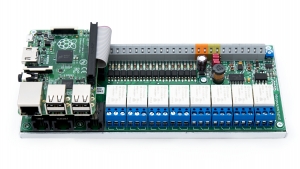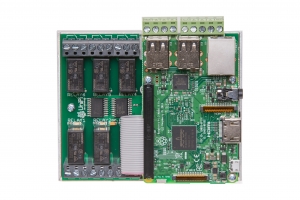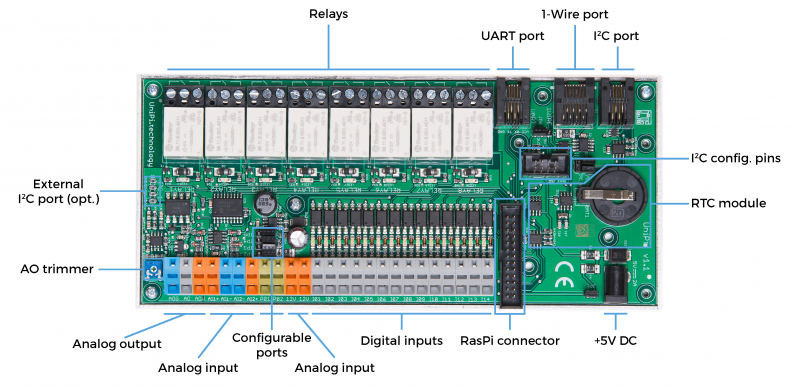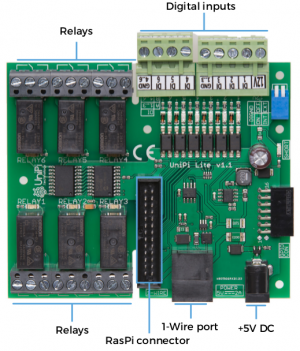This is an old revision of the document!
Unipi 1.1 & 1.1 Lite
Unipi 1.1
Unipi 1.1 is an extension board for Raspberry Pi. The board etends the Raspberry Pi by innputs and outputs to interac with other devices to function as a programmable logic controller (PLC) in a variety of automation applications.
Features
- 8x Finder 36.11.9.005.4011 changeover relays (rated for 250 V~ / 10 A or 30 V⎓ / 10 A)
- 12x galvanically isolated digital inputs (0-3.5 V⎓ voltage for logical 0 and 5-24 V⎓ voltage for logical 1, 5 ms minimum pulse lenght)
- 2x 0-10 V⎓ analog inputs
- 1x 0-10 V⎓ analog output
- 1 × 1-Wire port for connection to 1-Wire thermometers and other sensors
- 1 × I2C port for expansion
- 1 × UART port for external serial communications
- socket for RTC (real-time clock) battery
Unipi 1.1 Lite
Unipi 1.1 Lite is a smaller and simpler variant of the Unipi 1.1, designed for smallest automation projects. When compared to the Unipi 1.1, it features fewer I/O's but is more compact and cheaper.
Features
- 6x Omron G5Q-14-EU changeover relays (rated for 250 V~ / 10 A or 30 V⎓ / 5 A)
- 6x galvanically isolated digital inputs (0-3.5 V⎓ voltage for logical 0 and 5-24 V⎓ voltage for logical 1, 5 ms minimum pulse lenght)
- 1 × 1-Wire port for connection to 1-Wire thermometers and other sensors
- short circuit LED indication
Overview
Unipi 1.1 use Raspberry Pi computer as their computing module. Unipi 1.1 and Unipi 1.1 Lite board are compatible with the following Raspberry Pi models:
- Raspberry Pi 2 Model B
- Raspberry Pi 3 Model B
- Raspberry Pi 3 Model B+
- Raspberry Pi 4 Model B (all RAM variants)
Raspberry Pi can be purchased either separately, or as a part of one of the practical sets available on our e-shop.
The Raspberry Pi is connected via its GPIO through a ribbon cable, processes all data from I/O modules and is sending responses. All individual I/Os and communication interfaces are connected to the Raspberry Pi's CPU either directly via GPIO or indirectly via I2C. Raspberry Pi also provides network connectivity and USB ports.
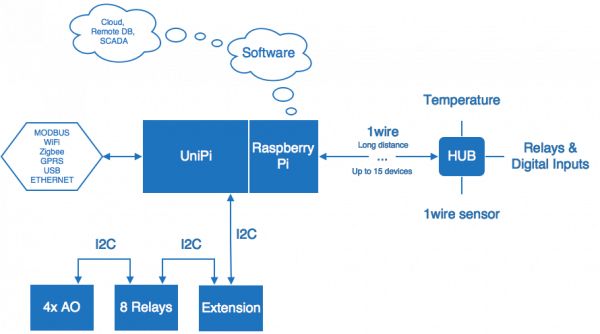
The I2C port supports connection of extension modules, such as the EMO-R8 relay extension.
The 1-Wire bus is used for passive reading of data from corresponding 1-Wire sensors (humidity sensors, temperature sensors etc.). One bus can receive data from up to 15 sensors with a maximum total length of the bus up to 200 meters (provided a suitable 1-Wire hub is used).
Note: Unipi 1.1 and 1.1 Lite require an external 5 V⎓ / 2.5 A power source with 2.1mm DC jack.
